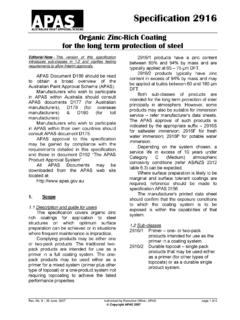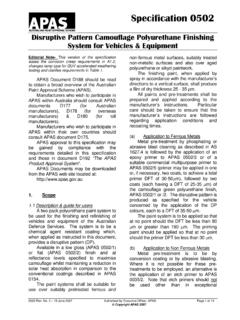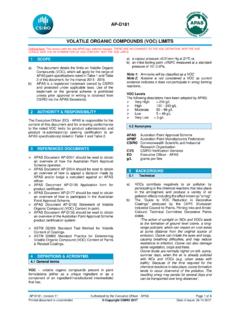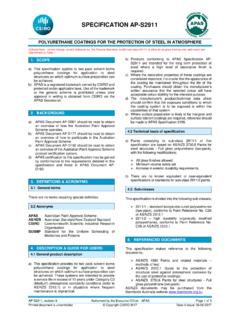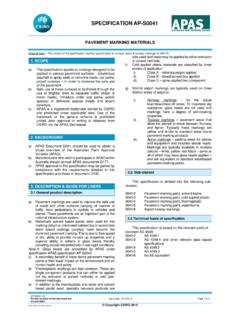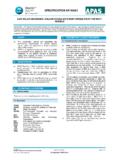Transcription of Categories and Classes - APAS-PCCP
1 PP-D007 painting contractor CERTIFICATION PROGRAM Categories AND Classes Editorial Note: This version of the document adds a new logo and updated references to weblinks. 1. SCOPE a) This document details the Categories and Classes under which PCCP accredits applicant contractors. b) PCCP is a trademark owned by CSIRO, administered by CVS and registered with IP Australia. Only financial Members of the Scheme may make use of the name, logo and benefits. For information on how to become a Member, refer to clause 7 of PCCP Document PP-D001. 2. AUTHORITY & RESPONSIBILITY a) The Executive Officer, PCCP (EO) has the authority to implement the requirements of this procedure. 3. BACKGROUND INFORMATION a) For information about how PCCP operates and how to apply for PCCP accreditation refer PCCP Document D001.
2 B) For information about PCCP costs and charges refer PCCP Document D003. 4. REFERENCED DOCUMENTS a) This procedure makes reference to the following PCCP documents; PP-D001 How PCCP Operates PP-D003 PCCP Schedule of Fees PP-D011 Accreditation requirements Class 18 Low VOC coatings for buildings PP-D013 Accreditation requirements Classes 2 - 4 PP-D014 Management of Hazardous Coatings Industrial situations ( Classes 5 to 6) PP-D033 Accreditation requirements Classes 20 to 29 All PCCP documents and forms are available for downloading from the Documents section of the PCCP web site at; The Poisons Standard (the SUSMP), PART 2 CONTROL ON MEDICINES AND POISONS, SECTION SEVEN/Appendix I PAINT OR TINTERS This document is available from the Australian Government - Department of Health - Therapeutic Goods Administration & via the Department s website at: AS 4361 Guide to Lead paint Management: - Part 1 Industrial applications.
3 Part 2 Residential & commercial buildings available from SAI Global offices in all capital cities & web site: 5. DEFINITIONS & ACRONYMS Definitions Hazardous coating heavy metal coatings containing any level of lead, chromium VI or other heavy metal ingredient listed in the Australian Uniform Paint Standard. Hazardous coating respirable dust coatings of various chemical types where removal operations eg by sanding poses potential risks to operators and/or the environment. Examples are coal tar epoxies, marine anti-fouling coatings, epoxies and polyurethanes etc. Acronyms AISF Australian Institute of Surface Finishing CSIRO Commonwealth Scientific and Industrial Research Organisation CVS CSIRO Verification Services group EO Executive Officer, PCCP PCCP painting contractor Certification Program PPE Personal protective equipment PTC PCCP Technical Committee UHB Ultra high build (epoxy) 6.
4 CLASSIFICATION OF ACTIVITY Categories a) The functional areas in which PCCP is active are classified according to their major Category. Within each Category are a number of Classes of activities. b) Categories cover the preparation of the substrate or surface to which the coating is to be applied and the actual application of the coating. c) The Categories in which PCCP is currently active are; 1. Protective coatings 2. Pavement markings 3. Architectural coatings 4. Powder coatings d) These Categories are described in greater detail below. PCCP D007 v11 Authorised by Executive Officer, PCCP Page 1 of 4 Date of issue 31/07/2017 Copyright CSIRO 2017 Hardcopies of this document are Uncontrolled. PP-D007 Categories AND Classes Category A Protective coatings a) This category covers the application of industrial and heavy-duty coatings designed principally for the long term protection of steel and concrete.
5 B) The coatings may be only for atmospheric exposure or they be for immersion service (salt or fresh water, sewage or buried). c) Included in this category is the management of hazardous coatings such as lead, chromate, coal tar epoxy and asbestos containing coatings. d) Criteria for ) lead coatings are based on the requirements contained in AS Category B Pavement markings a) This category covers the application and removal of coatings designed for roads, pavements and car parks etc. b) It encompasses waterborne paint, thermoplastic and multi component cold applied plastics and includes airport marking. Category C Architectural coatings a) This category covers the application of liquid coatings encountered in commercial and residential buildings and includes; i) the management of hazardous coatings by methods such as removal & repaint or encapsulation ii) application of seamless floor coatings to commercial buildings b) Criteria for )i) are based on the requirements contained in AS Category D Powder coatings a) This category covers the application of powder coatings to steel and aluminium in architectural applications (building elements) and general industrial steel and aluminium.
6 B) The requirements have been set with agreement of the AISF and represent an additional level of assurance over the Qualicote system. 7. Classes OF ACTIVITY AREAS Protective coatings a) In the Category of Protective Coatings there are five Classes of accreditation available. i) Class 2 Shop application of coatings ii) Class 3 Site application of coatings for atmospheric service iii) Class 4 Site application of coatings for immersion service iv) Class 5 Management of hazardous coatings, heavy metal containing (lead) v) Class 6 Management of hazardous coatings, respirable air-borne dusts. b) Class 2 is for the surface preparation and application of coatings in a steel fabricating shop with an enclosed spray painting facility. c) Class 3 is for the surface preparation and application of coatings on a customer s site, remote from the contractor s home base where the coating is mainly for exterior atmospheric exposure.
7 D) Application of Class 3 coatings is typically to substrates of either steel or concrete. e) The coatings that applicators would be accredited to apply would typically be conventional materials; zinc rich coatings, epoxy and most 2 pack exterior materials for atmospheric service. f) Organisations accredited to Class 3 shall be able to demonstrate experience in painting of typical facilities such as power stations, water/sewage treatment plants, food and beverage plants, structural steel or concrete used in dams and other "head works" applications. g) Class 4 is for the surface preparation and application of coatings on a customer s site, remote from the contractor s home base where the coating is mainly for immersion (water or soil) exposure h) For Class 4, applicators would be expected to be experienced in the application of protective coating for chemical, mining and offshore immersion service.
8 This Class covers the painting of all steel and concrete structures subjected to immersion and or abrasion. i) The coatings to be applied are normally high performance materials and some specialised lining materials. (eg. polyester, UHB epoxy and FRP) j) Organisations accredited to this Class shall be able to demonstrate extensive experience in painting , stripping and relining of typical facilities such as water reservoirs, internal surfaces of pipelines, steelwork immersed in fresh, salt or waste waters. k) Classes 5 & 6 are for the preparation of surfaces known to have coatings on them that have the potential to be hazardous to the contractor s employees, the general public and/or others in the near vicinity. These Classes also cover the application of fresh coatings over the appropriately prepared substrate.
9 PCCP D007 v11 Authorised by Executive Officer, PCCP Page 2 of 4 Date of issue 31/07/2017 Copyright CSIRO 2017 Hardcopies of this document are Uncontrolled. PP-D007 Categories AND Classes l) Class 5 is further divided into Class 5A and 5B, full containment and partial containment respectively. m) Class 5 requirements are based on AS in which the hazards and controls of lead are well documented. n) For Class 6 there is no equivalent AS document detailing hazards and controls. Until such a standard is developed, Contractors are expected to utilise the expert services of an industrial hygienist. o) Requirements for accreditation Classes 2 to 4 are defined in PCCP Document PP-D013 p) Requirements for accreditation Classes 5 & 6 are defined in PCCP Document PP-D014.
10 Q) Accreditation between Classes is not transferable. Pavement markings a) The pavement marking category is divided into eight separate Classes designed to cover the bulk of the pavement marking activities undertaken. These are described full in PCCP Document D031 and summarised in Table 1 below. b) A full description of requirements for accreditation in the Pavement Marking category can be found in PCCP Document D033. Architectural coatings a) This category is still in course of development and to date only Class 18 Application of floor coatings for commercial buildings, has been released. b) It is intended to progressively expand PCCP to cover the application of architectural coatings in both commercial and public buildings with specialist Classes such as management of existing hazardous paints.
